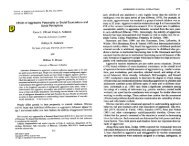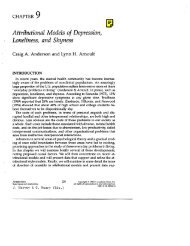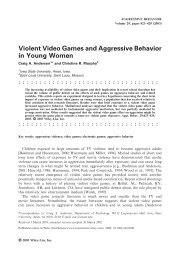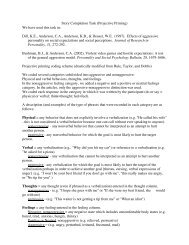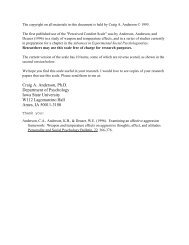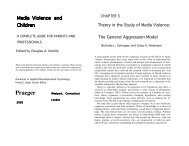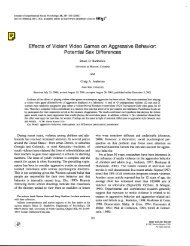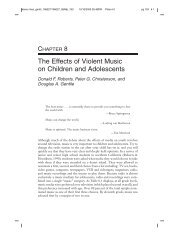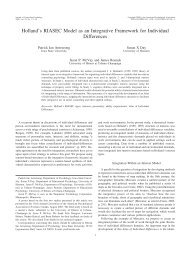The General Aggression Model: Theoretical Extensions to Violence
The General Aggression Model: Theoretical Extensions to Violence
The General Aggression Model: Theoretical Extensions to Violence
You also want an ePaper? Increase the reach of your titles
YUMPU automatically turns print PDFs into web optimized ePapers that Google loves.
252 DEWALL, ANDERSON, AND BUSHMAN<br />
harming his wife versus benefitting himself<br />
(e.g., feeling a sense of power and control in the<br />
relationship); and how much the man reflects on<br />
the consequences of violently battering his wife.<br />
Second, the therapist would provide the man<br />
with strategies designed <strong>to</strong> reduce his hostile<br />
affect (e.g., distraction, relaxation) and make<br />
him aware of the specific thoughts, feelings, and<br />
behavior related <strong>to</strong> his battering behavior that<br />
have become so deeply ingrained in his everyday<br />
life that they occur au<strong>to</strong>matically. Third, the<br />
therapist would give the man strategies designed<br />
<strong>to</strong> increase his thoughtful awareness of<br />
the violent thoughts, feelings, and actions related<br />
<strong>to</strong> his wife. Fourth, the therapist would<br />
work with the man <strong>to</strong> reduce his desire <strong>to</strong> cause<br />
harm <strong>to</strong> his wife (if that is his primary goal) and<br />
<strong>to</strong> develop a list of other activities he could use<br />
<strong>to</strong> feel that he plays an important and valued<br />
role in his marriage. Fifth, the therapist would<br />
provide the man with activities designed <strong>to</strong><br />
strengthen his self-regula<strong>to</strong>ry abilities, which<br />
may increase the likelihood that he will engage<br />
in thoughtful decision-making processes when<br />
he has the urge <strong>to</strong> batter his wife. As noted<br />
earlier, practicing self-regulation reduces IPV<br />
inclinations (Finkel et al., 2009), even when<br />
people practice self-regulation in domains that<br />
are unrelated <strong>to</strong> violence. Thus, GAM can inform<br />
IPV programs that can be tailored <strong>to</strong> specific<br />
aspects that are most relevant <strong>to</strong> an individual.<br />
Intergroup <strong>Violence</strong><br />
GAM can also help explain how <strong>to</strong> s<strong>to</strong>p persistent<br />
intergroup violence. Whereas previous<br />
interventions have focused on improving relationships,<br />
increasing care and empathy, and becoming<br />
cognitively aware of one’s aggressive<br />
urges (Shechtman & Ifargan, 2009), GAM suggests<br />
that understanding how <strong>to</strong> break the violence<br />
escalation cycle may also prove a useful<br />
intervention strategy <strong>to</strong> reduce intergroup violence.<br />
According <strong>to</strong> GAM, extinguishing persistent<br />
intergroup violence should occur under<br />
the following circumstances. First, Group A<br />
may perceive that the outcome of further aggressive<br />
retaliation is sufficiently important and<br />
unsatisfying that they should engage in thoughtful,<br />
as opposed <strong>to</strong> impulsive, actions <strong>to</strong>ward<br />
Group B. Next, Group B experiences Group A’s<br />
thoughtful response, which should not increase<br />
its aggressive affect, cognition, or arousal. As a<br />
result, Group B does not perceive Group A as<br />
hostile and threatening, leading it <strong>to</strong> refrain<br />
from further aggressive retaliation. This is an<br />
upward spiral rather than a downward one<br />
(Slater, Henry, Swaim, & Anderson, 2003).<br />
Thus, intergroup violence should s<strong>to</strong>p in the<br />
appraisal and decision process component of<br />
GAM. But, of course, this can occur only if the<br />
thoughtful process results in a decision <strong>to</strong> deescalate.<br />
Frequently, in international politics,<br />
this does not happen. In fact, formal political<br />
policies frequently endorse an escalation strategy<br />
on the oft-mistaken notion that “if we show<br />
the enemy that their provocations will only hurt<br />
them more, then they will back down.” <strong>The</strong>re<br />
may be cases, however, in which extreme escalation<br />
can end a conflict because one or more<br />
parties are simply unable <strong>to</strong> continue the escalation<br />
cycle.<br />
Even in cases of vastly unequal power, however,<br />
“relative” escalation may occur (Anderson<br />
et al., 2008). That is, the weaker side may not be<br />
able <strong>to</strong> retaliate at the same level as the stronger<br />
side, but it still may retaliate more strongly than<br />
it did before. Indeed, much international terrorism<br />
has this characteristic.<br />
<strong>The</strong> Israel–Palestinian conflict offers one example<br />
of how GAM can help explain how intergroup<br />
violence begins, persists—and how it<br />
can end. This intergroup conflict erupted several<br />
decades ago when Jews and Arabs exchanged<br />
violent attacks over a strip of land, alternately<br />
called Israel or Palestine, which Jews claim is<br />
their birthright and Palestinians claim as theirs.<br />
When will the Israeli–Palestinian conflict<br />
end? A GAM-derived intervention would begin<br />
by encouraging citizens from Israel, Palestine,<br />
or both countries <strong>to</strong> perceive that the outcome of<br />
their country’s retaliation is both important and<br />
unsatisfying. When this occurs, the relenting<br />
country will engage in reappraisal processing<br />
and thoughtful nonviolent action <strong>to</strong>ward the<br />
other country. <strong>The</strong> opposing country will experience<br />
a thoughtful, as opposed <strong>to</strong> an impulsively<br />
aggressive, action from the other country,<br />
which will disrupt the internal states and appraisal<br />
and decision processes that usually accompany<br />
acts from the other group. For this <strong>to</strong><br />
happen, of course, major belief systems (knowledge<br />
structures) must change and be replaced by<br />
a set of new beliefs, especially beliefs about<br />
each other and about the efficacy of violent



